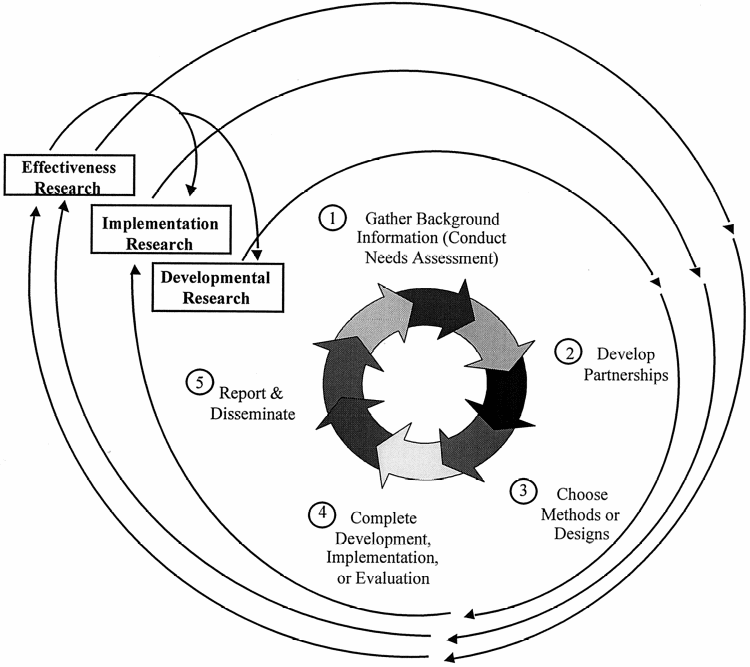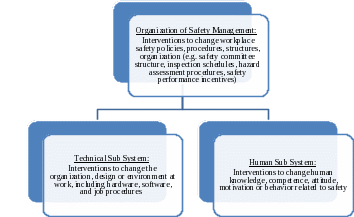Attch D-1.Relation of Project to Res. Agenda
Attch D-1.Relation of Project to Res. Agenda.docx
Musculoskeletal Disorder (MSD) Intervention Effectiveness in Wholesale/ Retail Trade Operations
Attch D-1.Relation of Project to Res. Agenda
OMB: 0920-0907
Attachment D:
Relation of the project to CDC’s broader research agenda
This project is part of CDC-NIOSH mission to conduct rigorous scientific intervention effectiveness research to support the evidenced-based prevention of occupational injuries and illnesses. In building a framework for assessing effectiveness, it is useful first to define prevention. CDC and other public health organizations generally recognize three types of OSH prevention activities:
Primary Prevention (activities to protect against injury/illness and disability)
Secondary Prevention (activities to identify and detect illness in its earliest stages when it is most likely to be treated successfully)
Tertiary Prevention (activities to treat injuries/illnesses early to limit disability through rehabilitation, restore functionality and self-sufficiency, and promote timely return to work)
Conducting research to support the evidence-based practice of all three types of OSH prevention is a major goal of CDC. In this decade, CDC-NIOSH outlined three key tenets that further provided a framework for future OSH effectiveness research:
1: Intervention research involves multiple phases: The National Occupational Research Agenda (NORA) Intervention Effectiveness Research team stressed that three phases (development, implementation, and effectiveness) are central to a model of intervention research and that all phases should be evaluated. Ideally, developmental, implementation, and effectiveness studies would be conducted in sequence. The findings from studies in each phase should be used to revise the intervention development and implementation, establishing a cycle of continuing improvement (Goldenhar et al 2001) (Figure D-1).
2: Effectiveness research should follow a framework of scientific rigor to support evidence-based practice: In 2001, CDC-NIOSH and the Institute for Work and Health (IWH), published a “Guide to Evaluating the Effectiveness of Strategies for Preventing Work Injuries”, DHHS 2001-119. The guide outlined that randomized, controlled trials are the accepted standard for determining cause and effect between interventions and outcomes, but that such studies are sometimes not feasible because of practical, ethical, legal, or other constraints. Other design options (e.g., quasi-experimental) and data collection methods (e.g., qualitative case studies) can be used when randomized, controlled experiments are not possible. “A sensible and economical approach to conducting OSH intervention effectiveness studies: conduct qualitative and quasi-experimental studies first, followed, if feasible, by randomized, controlled trials” (Goldenhar et al 2001). Finally, DHHS 2001-119 defined an intervention as “an attempt to change how things are done in order to improve safety. Within the workplace it could be any new program, practice, or initiative intended to improve safety (e.g., engineering intervention, training program, administrative procedure)” and advocated the investigation of three levels of intervention: Organization of Safety Management, Technical Sub System, and Human Sub System (Figure D-2).
3: Research to practice (r2p): In 2004, NIOSH launched the r2p initiative to emphasize that research should be relevant and responsive to the needs of practitioners and actively transferred to end users and stakeholders. As well, in as much that research should inform practice, so too researchers should recognize that practice often informs future research. Referring back to the multi-phase model of intervention research, many times the first two phases (development, implementation) are driven by practitioners, with effectiveness evaluations driven by researchers. For example, pro-active companies typically do not wait for OSH controls/ practices to be proven effective scientifically before developing and implementing controls on some scale. However, even the largest companies with the most generous OSH budgets want to determine some degree of effectiveness before implementing controls on a wide scale and are looking for research guidance. This type of natural participation in prevention research should be emphasized in collaborative partnerships. In essence, many industry leaders actively conduct quasi-experimental studies to first develop and implement controls and are often open to collaboration with researchers to develop randomized, controlled trials of the most promising controls so that evidence-based practices can be shared with the greatest audience possible.
Although much informative intervention research has been conducted, relatively few studies have followed the key tenets outlined above by CDC-NIOSH and practitioners are still seeking evidence to guide OSH practices at all intervention levels. Prior research has largely been limited to focusing narrowly on job task-level interventions and short term exposure or behavioral outcomes without addressing the multi-factorial nature of OSH programs (primary prevention through tertiary prevention) and the effect of supervisory and organizational level variables, or allowing sufficient timeframes to assess the full extent of disability or financial impact. Most OSH intervention effectiveness studies continue to be quasi-experimental (e.g. pre- and post- intervention studies without control groups or randomization). Although a randomized, controlled trial is often difficult to conduct in an OSH setting, the lack of such studies in the literature continues to be a perceived weakness of the OSH field. For example, recent and somewhat controversial literature reviews (Bigos et al. 2009; van Duijvenbode et al 2009; Sahar et al 2009; Tveito et al 2004) found few rigorous studies to support the efficacy of engineering ergonomic interventions designed to reduce low back pain (LBP).
Most MSD intervention effectiveness studies have been quasi-experimental (e.g. pre- and post- intervention studies without control groups or randomization). Those studies that have focused on the effectiveness of MSD engineering controls alone have tended to focus on short term workload assessments as outcomes rather than MSD symptoms/ cases and have been mixed in quality and findings (van der Molen et al 2005). Luijsterburg et al. 2005 conducted a controlled engineering intervention study with a follow-up period of 10 months was performed with 202 bricklayers from 25 construction companies. Analysis indicated no decrease in reported MSD symptoms as a result of the intervention, but sick leave in the intervention group was significantly lower compared to controls. Marras et al 2000 used an interrupted time-series quasi-experimental design involving 36 repetitive materials handling jobs and found a significant difference in pre- and post-intervention low-back incidence rates. Fujishiro et al 2005 conducted a prospective study to evaluate a statewide program (funded by the Ohio Bureau of Workers Compensation, OBWC) that provided consultation and financial support for purchasing devices to aid in patient handling and lifting. The median MSD rate decreased from 12.32 to 6.64 per 200,000 employee-hours between baseline (1 year pre-intervention) and post intervention (up to 2 years), indicating that the program was an effective intervention to reduce MSDs among healthcare workers.
A number of recent studies have examined the combined effect of MSD control programs that include engineering, administrative, and work practice controls and involve both management and employees in the improvement process. Some of the quasi-experimental studies investigating the effects of such participatory MSD control programs have found reductions in MSD outcomes. Collins et al 2004 investigated a “’best practices, musculoskeletal injury prevention program consisting of mechanical lifts and repositioning aids, a zero lift policy, and employee training on lift usage” in a quasi-experimental, pre-post design. The authors found “significant reduction in resident handling injury incidence, workers’ compensation costs, and lost workday injuries after the intervention.” Rivilis et al. 2006 used a longitudinal quasi-experimental design, comparing a participatory MSD control program at “one depot of a large courier company, with a nearby depot serving as a control. Evaluations focused on 122 employees across the two depots who participated in both pre- and post-questionnaires. Improvements in communication levels were associated with reduced pain intensity and improved work role function.” Authors concluded that a participatory MSD control program “can improve risk factors related to WMSD.” However, Haukka et al. 2008 conducted one of the few true experimental studies investigating the effect of a participatory MSD control program on MSD outcomes. This study used a cluster randomized control trial of 504 workers and 119 kitchens and determined that “no systematic differences in any outcome variable were found between the intervention and control groups during the intervention or during the 1-year follow-up.” Haukka notes that evidence for the effectiveness of MSD control interventions is “scanty” and is “mostly derived from case studies, while controlled trials are sparse and most have severe methodological flaws.” As described previously, recent literature reviews have found little evidence to support the efficacy of MSD control interventions designed to reduce low back pain (LBP). For example, Bigos et al. 2009 found “exercise interventions effective and other interventions not effective.” Other systematic reviews found a consistent lack of effectiveness of back supports (van Duijvenbode et al 2009) and shoe inserts (Sahar et al 2009). Tveito et al 2004 found that “only exercise and the comprehensive multidisciplinary and treatment interventions have a documented effect on LBP.”
Figure D-1: Multi-phase model of intervention research

Intervention development research studies provide answers to the following questions: (1) What changes are needed to enhance the health of the target population? (2) What are the best ways to bring about these changes? (3) What principles or theories in OSH might apply? (4) What barriers hinder the desired changes? (5) To what extent does the target audience understand and buy into the need for the changes?
Intervention implementation research helps answer such questions as: (1) What are the components (e.g., activities, materials, technology) of the intervention and how were they provided to the target audience? (2) What was the quality of the intervention components (e.g., were trainers well qualified, was equipment properly calibrated)? (3) How many and who in the target audience experienced the intervention? (4) Did certain workers reject the intervention? (5) How did implementation of the intervention deviate from expectations, and why?
Intervention effectiveness studies answer such questions as (1) To what extent does the intervention reduce occupational injuries, illnesses, disability, or fatalities? (2) To what extent does the intervention reduce worker exposure to hazardous conditions? (3) What is the effect of the intervention on the social and economic consequences of work injury and illness (e.g., worker compensation, medical and indemnity costs, quality of life)? (4) How have workers’ knowledge, attitude, or behaviors changed because of the intervention? (Goldenhar et al 2001).
Figure D-2: Levels of intervention in the workplace safety system

| File Type | application/vnd.openxmlformats-officedocument.wordprocessingml.document |
| Author | srw3 |
| File Modified | 0000-00-00 |
| File Created | 2021-01-31 |
© 2025 OMB.report | Privacy Policy